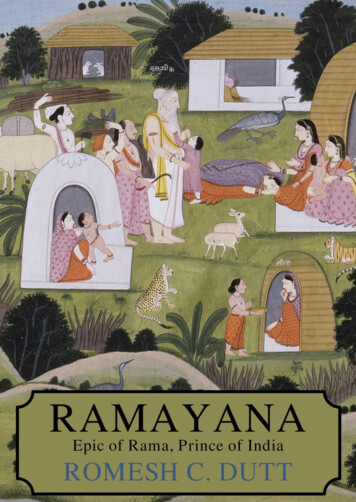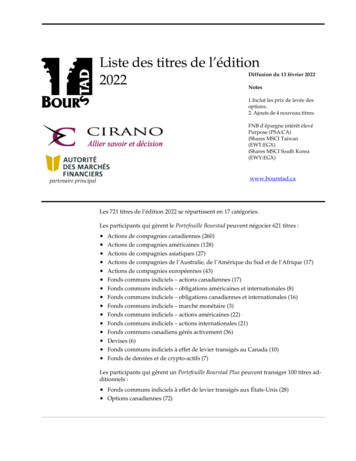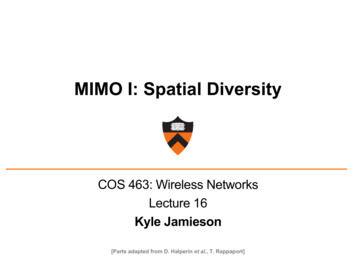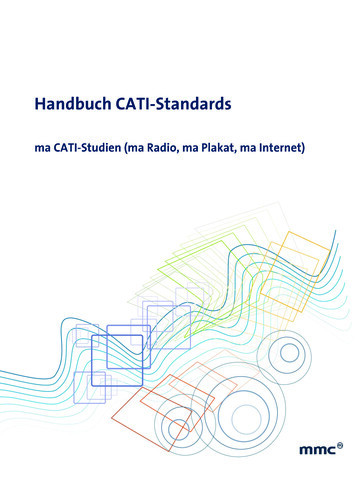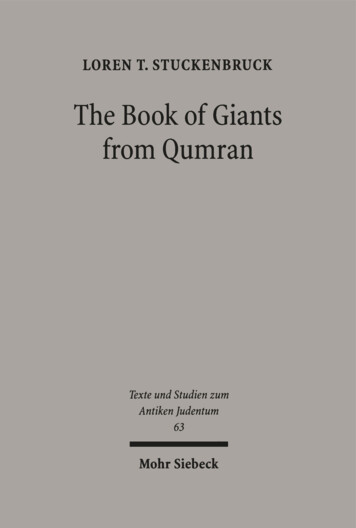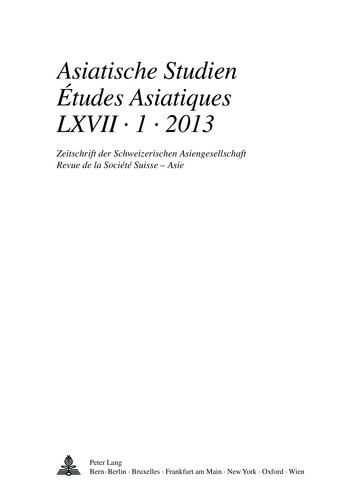
Transcription
Asiatische StudienÉtudes AsiatiquesLXVII · 1 · 2013Zeitschrift der Schweizerischen AsiengesellschaftRevue de la Société Suisse – AsieEdited by Roland Altenburger and Robert H. GassmannPeter LangBern · Berlin · Bruxelles · Frankfurt am Main · New York · Oxford · Wien
ISSN 0004-4717 Peter Lang AG, Internationaler Verlag der Wissenschaften, Bern 2013Hochfeldstrasse 32, CH-3012 Bern, Schweizinfo@peterlang.com, www.peterlang.comAlle Rechte vorbehalten.Das Werk einschließlich aller seiner Teile ist urheberrechtlich geschützt.Jede Verwertung außerhalb der engen Grenzen des Urheberrechtsgesetzesist ohne Zustimmung des Verlages unzulässig und strafbar. Das giltinsbesondere für Vervielfältigungen, Übersetzungen, Mikroverfilmungen unddie Einspeicherung und Verarbeitung in elektronischen Systemen.Printed in Hungary
INHALTSVERZEICHNIS – TABLE DES MATIÈRESCONTENTSNachruf – Nécrologie – ObituaryANDREA RIEMENSCHNITTER . 7Leung Ping-kwan (1949–2013)Aufsätze – Articles – ArticlesHENK W. BODEWITZ .31Vedic Terms Denoting Virtues and MeritsALFRED LEDER .75Ein geistreicher Exorzismus im Zhuangzi 19,6JONAS RÖLLIN .87Islam und Muslime im Kontext deutschschweizerischer ÖffentlichkeitJOHN TABER . 125On Engaging Philosophically with Indian Philosophical TextsLONE TAKEUCHI. 165Hermeneutics of Acrostics: From Knjkai to TsurayukiSonderbeitrag – Special contribution – Article particulierMAHMOUD LAMEÏ . 207Les manuscrits illustrés orientaux dans les institutions publiques en SuisseIV: Bibliothèque Universitaire de BâleAS/EA LXVII 1 2013
6INHALTSVERZEICHNIS – TABLE DES MATIÈRES – CONTENTSRezensionen – Comptes rendus – ReviewsVISHWA ADLURI / JOYDEEP BAGCHEE (EDS.) . 341Essays by Alf Hiltebeitel. Vol. 1. Reading the Fifth Veda. Studies on theMahƗbhƗrata. Vol. 2. When the Goddess Was a Woman. MahƗbhƗrataEthnographies. (Danielle Feller)ALEXANDER C. Y. HUANG . 345Weltliteratur und Welttheater. Ästhetischer Humanismus in derkulturellen Globalisierung. (Andrea Riemenschnitter)Autoren – Auteurs – Authors . 349AS/EA LXVII 1 2013
VEDIC TERMS DENOTING VIRTUES AND MERITSHenk W. Bodewitz, Leiden UniversityAbstractIn an other publication (BODEWITZ, 2007a) I have discussed the lists of cardinal sins and vices,their specifications in the Veda and their parallels in the Western and Christian tradition. Now Iwill treat their positive counterparts (the virtues and merits), which do not have such clear enumerations (and partial parallels outside the Veda).1 Here the meaning of a few terms used to denotevirtues and merits will be discussed, and an attempt will be made to get some information on theiractual contents and background.There are five Sanskrit equivalents for virtue or merit: gu۬á, dhárma, suk ܀ tám,pú۬yam and Ğobhanám2, but only suk ܀ tám and pú۬yam are regularly found in theVedic ritualistic and philosophical texts. They especially refer to meritoriousactions or their resulting merits.The adj. Ğobhaná (‘excellent, auspicious, virtuous’) and the neuter nounĞobhanám (‘something auspicious, virtue’) resemble pú۬ya and púnyam withtheir meaning and function, but are post-Vedic in this respect and therefore willnot be treated here. In his commentaries on Vedic texts SƗya a sometimes usesthese terms to explain the Vedic concepts of suk ܀ tá(m) and púnya(m). See thefollowing quotations made by GONDA, 1966: 116, n. 6 and 117: ĞobhanayƗgƗdƯnƗ ۦ kartƗ yajamƗna ;ۊ ĞobhanadƗnayuktƗya yajamƗnƗya and ĞobhanasyakartƗram.The term gu۬á seems to characterize the human qualities, pregnantly thegood qualities, excellences, merits, virtues. However, with these meanings it is12The cardinal virtues according to Plato are four: wisdom or prudence (sofia), fortitude(andria), temperance (sofrosune) and justice (dikaiosune), to which the Christian traditionhas added faith, hope and love or charity.See MYLIUS, 1992 (s.v. “Tugend”), who s.v. “Verdienst” again mentions suk ܀ tám andpú۬yam, and then adds pnjrtám, which clearly is a mistake, since it does not denote theconcept of merit as such but refers to a specific merit (namely reward, gift). See theDvandva compound i ܒ܈ Ɨpnjrtám which denotes two specific merits (see e.g. GONDA, 1965:237). In PƗli “Tugend” and “Verdienst” are i.a. denoted by puñña. See MYLIUS, 2008, s.v.AS/EA LXVII 1 2013, S. 31–73
32HENK W. BODEWITZalmost exclusively post-Vedic and especially found in the epics and Manu.Therefore it will be left out of account here.The duties of man, his prescribed virtuous conduct as well as its religiousmerits are denoted by the noun dhárma. As such it is likewise mainly post-Vedic(especially if the Vedic dharmasnjtras are left out of account).The virtues or merits called suk ܀ tám and pú۬yam play a role in contextsdealing with the aim of reaching heaven (and immortality). They will be discussed in the next sections.1. The merit of suk ܀ támThe suk ܀ tám (or suk ܀ tyƗ́) is accomplished by the suk ́܀ t (the virtuous or meritorious man) who on account of this suk ܀ tám mostly wins the world of suk ܀ támor of the suk ́܀ ts. Gonda, 1965: 129, correctly observes: “The suk ܀ ta ۊ are thosewho have acquitted themselves well of their religious duties, earned the meritsthereof and enjoy the reward of their ritual meritorious deeds in the otherworld.” See also p. 123 where “the world of religious merit” is indeed therequired translation.However, in a later publication (GONDA, 1966: 115–143) he changed hisideas. Now the suk ܀ tám is interpreted as something (especially or almost exclusively a ritual) which has been correctly or accurately carried out. The resultingmerit would be based on the good quality of the performance and the root karwould refer to the ritual work. The suk ́܀ t would be someone who is “doing(sacrificial) work well” (p. 118). The negative counterpart of the suk ́܀ t, thedu ܈ k ́܀ t, then would be someone who makes mistakes in the performance of thesacrifice, but Gonda only once mentions him (p. 121). His rather helpless observation on these ‘bad performers’ is: “who in any case are demeritorious peoplewho may be burdened with the sins and inauspicious deeds of the others”.His treatment of du ܈ k ܀ tám, the negative counterpart of suk ܀ tám, is referredto a mystifying meganote (p. 126–128), which makes it clear that Gonda herehas to admit that du ܈ k ܀ tám in fact means something like sin, vice or demerit. Fora criticism of Gonda’s interpretation of suk ܀ tám and of TULL, 1989, whofollowed Gonda, see BODEWITZ, 1998 (588, n. 11 and 590 f.) with furtherreferences (i.a. BODEWITZ, 1993).It is quite clear that suk ܀ tám denotes the merit which qualifies man for lifeafter death in heaven. It is also evident that in the ritualistic literature of theAS/EA LXVII 1 2013, S. 31–73
VEDIC TERMS DENOTING VIRTUES AND MERITS33Veda the best way for gaining merit is the ritual, but this does not imply that theactivity expressed by the root kar in suk ܀ tám would exclusively refer to the performance (by priests) of rituals of which the quality were to be expressed by su3.This means that more information on the nature of the merit denoted by the termsuk ܀ tám (to be distinguished from the adjective súk ܀ ta, which has a differentaccentuation and means ‘well made’) is required.1.1 What has to be done for obtaining merit (suk tám) and by whom?The term suk ܀ tám often or even mostly denotes the reward for particular positiveactions or behaviour stored in heaven for the human beings whose positiveactivity receives merits which produce a continuation of life after death in theheavenly world. This world is called the place, world or loká of the suk ܀ tám (theearned merit) or of the suk ́܀ ts (the meritorious human beings who are alreadyliving there), but the earth is the place where this merit can be produced. See V10, 61, 6, where in a description of the myth of cosmic incest the seed falls onthe surface (of the earth), in the source (or womb) (yóni) of suk ܀ tám. In theintroduction to this hymn, GELDNER, 1951, observes on this verse: “Der Inzestwird ausdrücklich als Guttat bezeugt.” The pouring out of seed may also beinterpreted as a sacrifice in which the seed as an oblation is poured on the earthregarded as the sacrificial place where the future benefits are produced. Cf. V3, 29, 8, where Agni is asked to place the sacrifice (yajñá) in the birthplace ofmerit (suk ܀ tásya yónau). GONDA, 1966: 143, prefers the translation “birth-placeof the meritorious act”. However, the yóni is the place out of which merit is produced (by an activity which is meritorious). That the result of a sacrifice is denoted by suk ܀ tám also appears from a verse in TS 7, 3, 11, 2, where the sacrificeis said to produce merit (suk ܀ tám) (i.e. continuation of life in heaven), cattle andoffspring.The reward for positive activity looks like the doctrine of karma, which,however, is not restricted to a life after death in heaven, but also refers to rebirthon earth (directly after death or after a limited stay in heaven). Moreover, life3See HORSCH, 1971: 127: “Besonders aufschlussreich ist in diesem Zusammenhang der Terminus suk ܀ tá, ‘Guttat’, da er bereits eine moralische Nuance enthält. [ ] Sicherlich ist dieses Handeln noch vorwiegend rituell bestimmt, so dass der Ausdruck ‘Tugend’ für suk ܀ tánur beschränkt zutrifft.” His approach is rather confusing. I prefer to interpret suk ܀ tám asmerit, a more general term than virtue, which moreover may include items outside thesphere of morals like sacrifices.AS/EA LXVII 1 2013, S. 31–73
34HENK W. BODEWITZafter death in heaven where one enjoys some sort of continuation of the earthlylife, is not the ultimate aim of the doctrine of karma which is associated with thetheory of mok ܈ a (missing in the oldest phases of Vedic religion). So at best onemay regard the ideas about suk ܀ tám (meritorious activity and the resulting meritstored in heaven) as predecessors of the doctrine of karma.4 Rebirth on earth isnot based on merits, but qualified by the moral or ethical good or bad nature ofone’s behaviour. Release from this rebirth is not produced by merits or ethicsand only plays a role in late Vedic texts.The connection of suk ܀ tám with Vedic ritual is not to be denied and is evento be expected in Vedic texts, which mainly deal with ritual. Now the followingquestions remain to be answered. Does the meritorious behaviour exclusivelyconcern the ritual? Are the suk ́܀ ts who obtain the merit of their activities (thesuk ܀ tám in heaven) the sacrificers (YajamƗnas) or the priests in case the heavenly suk ܀ tám would be obtained by means of sacrifices denoted as suk ܀ tám? DoesGonda’s interpretation of suk ܀ tám as ‘well and accurately performed ritual’exclude the role of the YajamƗnas, who hardly carry out actions in the ritual?There are not many passages in the Vedic literature in which the conceptsof suk ܀ tám and suk ́܀ ts evidently do not concern the performance of rituals. Inmost contexts these terms explicitly refer to the ritual or at least do not excludetheir association with rituals. The following examples form an exception.1.2 The non-sacrificial suk támIn BƖU 6, 4, 3, a man appropriates the suk ܀ tam of a woman with whom he hassexual intercourse, if he has a particular knowledge about the symbolism of thisact and of the role of women in this connection. GONDA, 1966: 121, n. 30, refersthis passage to a note and does not explain what is “the ‘merit’ of the women”here. It is clear that this merit cannot have been accumulated by sacrifices, since4See BODEWITZ, 1998: 589 ff. BOLLÉE, 1956: 38, even translates suk ܀ tam with “good karma”in ৡaঌvB. 1, 6, 1. GONDA, 1966: 129, accepts this rendering more or less and states that it“may do duty for practical purposes”, but also observes: “The only question [ ] is that as tothe character of the ‘good karma’, how and by what activities it was acquired. The contextitself points, of course, in the direction of ritual performances.” It is true that the context ofthis passage is ritualistic and deals with expiatory measures against ritualistic mistakeswhich may deprive the deceased in heaven from enjoying their merits (suk ܀ tam), but thepassage does not state that the mentioned merits had been obtained by the discussed ritual(with its faults) or by ritual at all.AS/EA LXVII 1 2013, S. 31–73
VEDIC TERMS DENOTING VIRTUES AND MERITS35women do not carry out sacrifices or organize them, as the YajamƗnas do; theyare only present.The text continues (6, 4, 4) with the statement that the men concerned leavethis world at death without merits (visuk ܀ tas), if they miss the knowledge required for this situation, since they lose it to the women concerned. Gonda (whotranslates visuk ܀ tas with “devoid of merit”) observes: “The very occurrence ofthe compound vi-suk ܀ t- corroborates the view that suk ܀ t- was a fixed, more orless ‘technical’ term.”5 This may be correct (apart from the wrong analysis visuk ܀ t- instead of vi-suk ܀ ta-; see n. 5), but would imply that suk ܀ tám primarilymeans ‘merit’ and that the exact nature of the origin of this merit need not be theaccurate performance of a ritual.See also BƖU 6, 4, 12, where the Dvandva compound i ܒ܈ Ɨsuk ܀ te (referringto the sacrificed material or the sacrifice as such and the merit which are takenaway from someone) implies that suk ܀ tam need not be identical with the sacrifice. All translators of this place distinguish suk ܀ tam from the merits earned bysacrifices. The Dvandva compound i ܒ܈ Ɨsuk ܀ te looks like a variation of i ܒ܈ Ɨpnjrtam and this means that suk ܀ tam here is identical with pnjrtam, the merit ofgiving to human beings instead of offering to the gods.6 The liberality expressedby pnjrtam is not limited to giving presents to individuals (i.e. dƗnam) but mayalso refer to benefactions like establishing resthouses where all travellers mighteat from one’s food (as king JƗnaĞruti did according to ChU 4, 1, 1). So pnjrtamis like suk ܀ tam a form of doing good.A woman also plays a role in connection with suk ܀ tám in V 10, 95, 17,where Purnjravas asks for UrvaĞƯ’s return and then says: úpa tvƗ rƗtí ۊ suk ܀ tásyatí ܒ܈ hƗn ní vartasva, which GELDNER, 1951, translates “Auf dass der Lohn derGuttat dir zuteil werde, kehre um”. GONDA, 1966: 125, n. 49, interprets rƗtí ۊ suk ܀ tásya as “the gift of the well-prepared offering” and observes that the mortalPurnjravas warns UrvaĞƯ: “if she departs without more, the fruits of her deedsmay not await her”. However, UrvaĞƯ is an Apsaras and a woman and does notsacrifice and therefore cannot wait in vain for the merits of sacrifices stored forher in heaven. Probably her suk ܀ tám is her return to Purnjravas and the reward56Gonda makes the impression of analysing visuk ܀ t as vi-suk ܀ ta (‘without suk ܀ ta’), which isnot possible, since the prefix vi- is followed by suk ܀ t and not by the noun suk ܀ tam. However,it is evident that the correct reading of the compound in the plural should be visuk ܀ tƗs. SeeBƖU 6, 4, 12 and KauৢU 1, 4, where visuk ܀ ta occurs in the singular and means ‘withoutsuk ܀ tam’.See n. 2.AS/EA LXVII 1 2013, S. 31–73
36HENK W. BODEWITZwould be given by him in the form of a nice renewal of their association (perhaps with sexual implications).The fact that suk ܀ tam occurs together with two other terms of which the onerefers to (i.a.) the sacrifice (i ܒ܈ Ɨpnjrtam) and the other to asceticism (tapas) in JB1, 97 may be an indication that suk ܀ tam does not simply mean the correct performance of a ritual. The sentence asmin vƗ aya ۦ loke pu۬ya ۦ jƯvitve ܒ܈ ƗpnjrtenatapasƗ suk ܀ tenƗsmƗn anvƗgami ܈ yati admits of various interpretations in as far asthe construction is concerned. CALAND, 1919: 20, may be right in taking thethree instrumentals with anvƗgami ܈ yati and translating “dieser wird, nachdem erauf dieser Welt [ ] gut gelebt hat, durch Opferverdienst, Askese, Guttat unsnachfolgen.” My own translation (BODEWITZ, 1990: 111) runs: “Having lived ameritorious life in this world with sacrificing and liberality, asceticism and gooddeeds he will follow us (and reach heaven)” and assumes that the pu۬ya way oflife in general is decisive. Anyhow, the context (1, 98) makes it clear that goodbehaviour rather than perfectly performed ritual is at stake. The gods introduceevil or bad behaviour in this world for man in order to prevent his rising toheaven. They even appoint Agni to obstruct the successful attempts to reachheaven of him who has overcome the innate, evil traits given to him by the godsand wants to behave in a virtuous way (yas [ ] asmin loke sƗdhu cikƯr ܈ Ɨt). I amconvinced that sƗdhu (k )܀ , pu۬yam (jƯv) and suk ܀ tam more or less belong together in this passage and refer to good behaviour, whereas correct performanceof the sacrifice does not play a role here.77The parallelism of the suk ܀ t and the pu۬yak ܀ t had to be admitted by GONDA, 1966: 120, whonevertheless translates suk ܀ tas with “those who have acquitted themselves well of their ritualduties” and pu۬yak ܀ tas with “those who do right-good-pure deeds”. It is obvious that bothhave a meritorious behaviour and that the correctness of the performance of rituals hardlyplays a role. The ritual as such rather than its exact performance produces the merit. ForsƗdhuk ܀ tyƗ representing suk ܀ tam see also JB 1, 18, where after having reached the suk ܀ tarasa the deceased gives the sƗdhuk ܀ tyƗ to the Pit s. In this late Vedic passage the deceaseddoes not need any more his suk ܀ tam, since by knowledge of his identity with the highest godhe has become released. On the other hand, Ka৬hU 2, 24 does not regard knowledge alone assufficient and states that duĞcaritam ( du ܈ k ܀ tam) forms a hindrance. That this sƗdhuk ܀ tyƗ( suk ܀ tam) refers to virtuous behaviour in general appears from the parallel passage JB 1,50, where the deceased gives to his forefathers whatever pu۬yam he had done in his life andthis pu۬yam is in the same passage denoted by the term sƗdhuk ܀ tyƗ. His enemies receive hispƗpak ܀ tyƗ. This opposition between relatives and enemies who receive one’s merits anddemerits in general (without any clear association with good and bad sacrifices) is expressedby KauৢU 1, 4 with an opposition between dear relatives and enemies (or relatives who arenot dear) who receive suk ܀ tam and du ܈ k ܀ tam. The transfer of merits has a counterpart in aAS/EA LXVII 1 2013, S. 31–73
VEDIC TERMS DENOTING VIRTUES AND MERITS37The agreement of suk ܀ tam and pu۬yam also appears from the fact that theessence or fluid form (representing food in life after death?) (-rasa) of meritorious behaviour (i.e. the merit in heaven) may be preceded in a compound bysuk ܀ ta- as well as by the genitive of pu۬yak ܀ tyƗ. See JB 1, 18 and JUB 3, 3, 4, 6,where the deceased comes to the suk ܀ tarasa in heaven and JUB 1, 9, 3, 4, wherethe “sap of good action” (pu۬yak ܀ tyƗyai rasa ۊ , see OERTEL, 1894) is situatedbeyond the sun.Even a human being may be denoted by the term suk ܀ tam. In AƖ 2, 4, 2 thedeities refuse to enter a cow or a horse arguing that these living beings are notgood enough for them. They approve of man and say suk ܀ ta ۦ bata and the textexplains this with puru ܈ o vƗva suk ܀ tam. I think that the first suk ܀ tam means‘Well done!’ and the second ‘something meritorious’ or ‘the origin of merit’(just like the place of the sacrifice is the place where merits are produced). Thereseems to be a wordplay of súk ܀ tam ( sú k ܀ tám) and suk ܀ tám in this passage,which unfortunately has no accentuation.In ĝB 4, 1, 4, 5, two persons (a king and his Purohita) are associated withdu ܈ k ܀ tám and suk ܀ tám in case one of the two is without special merits and theircooperation would be unsuccessful. EGGELING, 1885, translates: “[ ] let not aBrƗhman desire to become the Purohita of any one Kshatriya (he may meetwith), as thereby righteousness and unrighteousness unite; nor should a Kshatriya make any BrƗhman (he may meet with) his Purohita, as thereby righteousness and unrighteousness unite.” GONDA, 1966: 126 f., n. 53, criticizes Eggelingand observes: “The suk ܀ tam in all probability consists in having, or being, a(competent) purohita, the du ܈ k ܀ tam in making someone a purohita who mayprove unfit for this profession or in serving an unworthy kৢatriya. If this interpretation is not beside the mark the suk ܀ tam results from the correct observanceof the social and religious rules, of the dharma, the du ܈ k ܀ tam from their disregard.” Gonda overlooks the fact that not the choice of a Purohita or his acceptation of the invitation as such are suk ܀ tám or du ܈ k ܀ tám, but that one of the twopersons may represent suk ܀ tám and the other du ܈ k ܀ tám. These two persons arequalified as merit and demerit (suk ܀ tám and du ܈ k ܀ tám). It seems that Gonda wasmisled by the neuter form of the two nouns, which here definitely refer totransfer of demerits. The merits expressed by suk ܀ tam may partially consist of sacrifices butneed not exclusively be produced by sacrifices let alone by the quality of their performances.AS/EA LXVII 1 2013, S. 31–73
38HENK W. BODEWITZpersons. The possible suk ܀ tám associated with a king has nothing to do with hisritual experience, nor does his possible du ܈ k ܀ tám with his inability in rituals.8The localisation of suk ܀ tám mostly is heaven (the destination of meritearned on earth) or (on earth) the place of sacrifice. There are some exceptions.In V 10, 85, 24 the bride becomes separated from the house of her parents andplaced in the womb of order ( ܀ tásya yónau) and the world of merit (suk ܀ tásyaloké) together with her husband; i.e. she becomes lawfully married. GONDA,1966: 142, rightly criticizes the translation of (i.a.) GELDNER, 1951, in which theworld of suk ܀ tám is interpreted as heaven, but does not deny that the sacrifice onearth cannot be meant here. He supposes that the localisation should be taken as“the married state regarded as a manifestation of ta and of (the merit gained by)right action”.9 Indeed lawful marriage (i.e. started according to ta) is a stage oflife in which the bride (on account of her association with her husband) maygain merit (suk ܀ tám). However, the winning of merit by sacrifices hardly plays arole here.On the same page Gonda deals with AV 14, 1, 59, where the bride leavesthe house of her parents and the gods should place her in suk ܀ tám (in the futurehome?). He concludes: “Here the term practically comes to ‘happiness’. [ ]Suk ܀ tam used here without any reference to ritual activities and merits seems tohave acquired a more or less fixed character, but we should remember thatmarriage too is a ritual act.” So it is not clear whether Gonda regards the suk ܀ támin which the bride is placed as the “married state” (see above) or as a marriageritual. His remark on suk ܀ tám having developed (from the bliss of merit obtainedin heaven and based on perfectly carried out rituals) to a “more or less fixed character” of happiness in general, raises some questions, since the AV is not a verylate Vedic text. I suppose that married life is suk ܀ tám because it potentially89After this unconvincing treatment of ĝB 4, 1, 4, 5, Gonda continues his note with commentson several passages in which du ܈ k ́܀ t and du ܈ k ܀ tám are discussed and the association of theseterms with the ritual becomes more and more vague. At the end of his note 53, Gondadiscusses AB 2, 7, 12, where the formula “O slayers, whatever shall here be well done, to usthat; whatever ill done, elsewhere that” is used in addressing the slayers of the sacrificialvictim. Gonda assumes that the correct or wrong performance is meant here. Indeed, theprose context seems to explain it in some way like this. However, the killing as such may beassociated with merit and demerit. The slayers receive the demerit of the cruel action, thepriests and the sacrificer the merit. The correctness of the ritual does not play a role in theformula.On such a non-physical, non-cosmographic ‘world’ see also GONDA, 1966: 68, discussingthe bhadrasya loka and referring to “English phrases such as ‘the scientific world, the sporting world’” by way of comparison.AS/EA LXVII 1 2013, S. 31–73
VEDIC TERMS DENOTING VIRTUES AND MERITS39provides the opportunity of gaining merit (especially in comparison with thestate of being an unmarried woman). There is no implication of rituals, let aloneof sacrifices, and certainly not of their accurate and correct performance.In V 7, 35, 4 the suk ܀ tƗni of the suk ́܀ ts are invoked for the human beingsand RENOU, 1959: 40, rightly translates “Heur nous soient les bienfaits des(dieux) bien-faisants”, because rituals and deceased sacrificers cannot play a rolehere.1.3 The role of the YajamƗna as the suk ́tMan and wife are both called suk ́܀ t in AV 12, 3, 44. Both are indeed involved inan Atharvavedic ritual in which a meal is offered as a Dakৢi Ɨ. The epithettranslated with “performing pious deeds” by BLOOMFIELD, 1897: 191, is rathergeneral and hardly refers to the correctness of their ritual activities (i.e. thecooking of the meal), but concerns their willingness to organize such a ritual andto give the meal to the priest. The accurateness of their contribution to thissimple ritual does not play a role.Two suk ́܀ t’s are mentioned in V 3, 31, 2. The one seems to be the makeror producer of the sacrificial fire (i.e. the priest), the other he who takes theprofit (i.e. the YajamƗna). The hymn is rather obscure. If the given interpretationis correct, the YajamƗna may be the one who obtains the suk ܀ tám (the merit) asan ƖhitƗgni, whereas the priest is the one who carries out the meritorious action(the AgnyƗdhƗna). GONDA, 1966: 118, criticizes Geldner’s translation “Guttäter”. It is possible, however, that two meanings of the term are used in thisobscure hymn. As ‘skilful’ it applies to the priest who produces fire, as ‘doinggood’ it denotes the organizer of the AgnyƗdhƗna, the sacrificer. The priest doesnot win the suk ܀ tám in heaven. This merit is for the sacrificer.10In several passages the YajamƗnas are explicitly called the doers and winners of suk ܀ tám. The participle ƯjƗná is used with the noun suk ́܀ t and then indicates that the suk ́܀ t has been a YajamƗna. See e.g. AV 9, 5, 8 and 12 occurringin a hymn dealing with the offering of a goat and five rice-dishes. Here theworld of the suk ́܀ t’s is that of men who have organized sacrifices, paid theofferings and given Dakৢi Ɨs to the Brahmin priests. The priests are not thesuk ́܀ t’s. It is the YajamƗna who meets after death with the merit of what he hassacrificed to the gods and given to human beings (especially priests). See e.g. TS10See JAMISON, 1991: 19, who observes that the priests do the actual ritual work and that theYajamƗna derives all the benefit from the ritual.AS/EA LXVII 1 2013, S. 31–73
40HENK W. BODEWITZ3, 3, 8, 5 where he comes together with his i ܒ܈ Ɨpnjrtá (i.e. what he has offeredand given). Therefore GONDA, 1966: 131, is wrong in translating suk ́܀ tƗmoccurring in AV 9, 5, 8 in apposition with ƯjƗnƗ́nƗm with “who have performedthe ritual well”, since the YajamƗnas are not the performers. According to AV11, 1, 17, the cooker of the rice-dish goes to the world of the suk ́܀ t’s and therefore is a suk ́܀ t himself. This cooker, however, is not a priest, but a YajamƗnawho makes his wife cook the Brahmaudana for the Brahmins. His merit is thegiving of the meal and the quality of the cooking is rather irrelevant.On these YajamƗnas see further AV 18, 3, 20, where ancient sacrificers aredescribed as i ܒ܈ Ɨvantas (having offered to the gods), rƗti ܈ Ɨco dádhƗnƗ ۊ 11 (giversof presents), dák ܈ i۬Ɨvantas (givers of Dakৢi Ɨs), suk ́܀ tas (meritorious men). It isclear that the suk ́܀ t is a suk ́܀ t because he gives goods to gods and priests and thathis doing good has nothing to do with the correctness of the performance of theritual.12 See also V 10, 122, 3, where Agni is addressed, and GONDA, 1966:116, mistranslates dƗ́Ğad dƗĞú ܈ e suk ́܀ te with “when thou givest to the giver whoperforms (his ritual) work well”. The YajamƗna13 is someone who does good bygiving and therefore Agni gives to him.The hymn V 1, 125 consists of a conversation between a rich host and hisguest, who is an itinerant singer and wants to have Dakৢi Ɨs or presents ingeneral from his host. Liberality rather than a great sacrifice (which cannot beorganized ad hoc) let alone the correctness of its performance plays a role. HereGonda, 1966: 117) is aware of this fact and does not refer to the accurateness of111213WHITNEY, 1905, misinterprets these two words as “attached to giving [ ] bestowers”. Seealso GONDA, 1966: 117, who translates them with “dispensing gifts [ ] bestowing”. Thesepersons make (dhƗ) other people (in general, or Brahmins) receivers (sƗc) of gifts.The correctness of the performance of the sacrifi
not be treated here. In his commentaries on Vedic texts S ya Æa sometimes uses these terms to explain the Vedic concepts of suk tá(m) and púnya(m). See the following quotations made by GONDA, 1966: 116, n. 6 and 117: obhana-y g d n æ kart yajam na Ê; obhanad nayukt ya yajam n ya and obhanasya kart ram.
